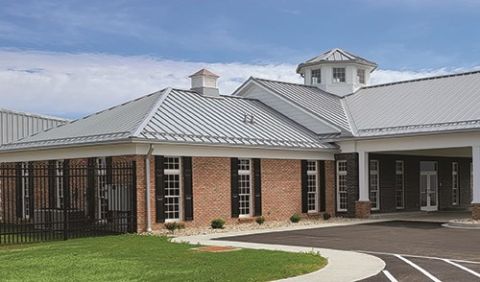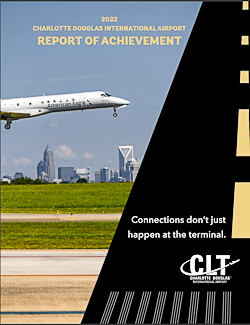Newark-Heath Airport Makes Major Upgrades

Located about 40 miles east of Columbus, OH, Newark-Heath Airport (VTA) is in one of the fastest-growing areas in that state. Currently, the general aviation airfield logs about 13,000 operations a year, but traffic is expected to escalate based on Intel’s plans to invest $20 billion in the area, including a large manufacturing plant that will produce semiconductor chips. The company expects to create up to 3,000 new jobs in the next few years—including many high-wage software engineering positions.
 To meet a likely surge in activity at the airport, VTA officials knew they had to improve several facilities. But before any changes could be made, they had to satisfy federal regulations concerning the airfield layout. “The FAA had ruled that our old terminal, maintenance building and a few other buildings were too close to the taxiway, and had to be moved or removed,” states Terry Treneff, president of the Licking County Regional Airport Authority. “Any new renovations had to resolve those issues.”
To meet a likely surge in activity at the airport, VTA officials knew they had to improve several facilities. But before any changes could be made, they had to satisfy federal regulations concerning the airfield layout. “The FAA had ruled that our old terminal, maintenance building and a few other buildings were too close to the taxiway, and had to be moved or removed,” states Terry Treneff, president of the Licking County Regional Airport Authority. “Any new renovations had to resolve those issues.”
For help navigating the FAA requirements and its own wish list for a new terminal and other improvements, VTA hired engineering consultant Crawford, Murphy & Tilly. It was awarded a five-year contract in late 2019 and began planning in January 2020.
|
facts&figures Project: New Terminal Location: Newark-Heath Airport, in Ohio Annual Operations: 13,000 Terminal Size: 4,300 sq. ft. Cost: $2.7 million Funding: 75% FAA; 20% county, 5% state Construction: June 2022-July 2023
Engineering/Design Consultant: Crawford, Prime Contractor: Robertson Construction Services Associated Projects: Community box hangar; 13 T hangars; terminal apron/taxi lane; airfield electrical vault; new maintenance facility; relocating buildings away from main taxiway Electrical & Lighting Equipment: Jess Howard Electrical Storage & Maintenance Hangars: Slaybaugh Construction Maintenance Hangar Relocation: Dingey Movers Environmental Systems Manager: EHS Company T Hangars: Robertson Construction Services Airside Ramp: Kwest Demolition of Old Terminal: GM Construction Terminal Security Fence: Ables Fence Camera System: Mid-Ohio Security Phone & WiFi Systems: Centratech FBO: Aviation Works |
Key projects included:
- new terminal;
- community box hangar;
- 13 new T hangars;
- terminal apron/taxi lane;
- new airfield electrical vault;
- new aircraft maintenance hangar facility;
- relocating existing maintenance building about 300 feet away from the terminal and main taxiway; and
- demolishing a few older buildings.
“This project had several [interrelated] moving pieces,” Treneff remarks. “For example, we could not tear down the old maintenance building until the new maintenance building was up and running. Our FBO could not be moved until the new terminal building was completed.”
The centerpiece of the entire plan was building a new $2.7 million terminal. “In our planning meetings with airport officials, we wanted to create a gateway into our region that would reflect its growing prosperity and importance,” explains Greg Heaton, vice president and Aviation Group manager for Crawford, Murphy & Tilly. “We wanted a building that is much more upscale and distinctive than is found at a typical general aviation airport.”
The new facility was built about 450 feet away from the old terminal, comfortably separated from active airfield areas. At nearly 4,300 square feet, it is more than three times the size of the old terminal, with a spacious lobby, conference room, pilot lounge, kitchen, FBO office, restrooms and storage. Designers incorporate plaques and photos highlighting the history and geography of Licking County.
The new FBO maintenance hangar is 64 feet wide by 78 feet long and includes a shop, restroom and storage space. It is located just 50 feet from the main terminal.
One of the more unusual aspects of this project involved relocating the airport’s existing steel maintenance building. Crews lifted the building off its foundation and used four radio-controlled mobile jacks to move the building, and then place it on a new foundation and slab about 300 yards away from the taxiway.
“We had to wait on moving this building until the new terminal building and the new maintenance hangar were finished, so the FBO could continue to operate. In the end, just moving the old building instead of building a brand new one saved us a lot of money,” Treneff explains. “I had a bid of $1.1 million to build a new hangar, but using this method the cost was only $190,000.”
Now in its new location, the old maintenance hangar is used to store tractors, trucks and mowers.
Unexpected Funding Source
The project at VTA was one of the first two in Ohio to receive funding through the FAA Airport Terminal Program grants, a new funding source included in the Infrastructure Investment and Job Act (IIJA) passed in 2022. The $1.85 million awarded for this project, along with a $383,000 Airport Improvement Grant, was pivotal in helping the county upgrade VTA.
“Originally, we expected to have to get a long-term loan to do these improvements,” Treneff explains. “But just as we were seeking financing, we received the extra funding from the Airport Terminal Program. This allowed us to make all of the improvements in our original plan without going into debt.”
In the end, FAA covered about 75% of the project cost, with the county and state picking up the rest of the tab (20% and 5%, respectively). Final cost of the terminal project was about $2.7 million.
Added Environmental Challenges
Designing and constructing the new terminal over an environmental sparge system presented special challenges.
Decades ago, an oil production facility located north of the airport leaked toxins into the underground water table. In the 1990s, the Environmental Protection Agency identified and began tracking a sizable plume of benzene in the ground, and an underground oil remediation sparge system was installed to address it. The sparge includes a system of PVC pipes buried at shallow (1 to 3 feet) and deeper positions (10 to 11 feet), as well as monitoring wells and valve access points throughout the airport’s former and current terminal areas. The system introduces high-pressure air beneath the contaminated soils and recaptures it in the upper pipe network. This creates a remediating effect on the benzenes and facilitates the collection of discharging methane gases for proper disposal. The approach is somewhat similar to the system of pipes that stick out of the ground at landfill areas.
When designing and constructing the new terminal and maintenance hangar facilities, the project team avoided the pipe system whenever possible and relocated elements when required. Observation well points and valve access points were considered key locations. Designers also added a vacuum piping system under the building to eliminate the vapor odor.

The porous nature of the soil at the building site was another challenge. The ground would not provide sufficient support for the new terminal’s foundation system, so Crawford, Murphy & Tilly evaluated several alternate solutions. Ultimately, engineers designed rammed aggregate piers to support a traditional building foundation. The system uses soil displacement to strengthen soft soils through a method that prestrains and prestresses it. Although such systems are common in certain regions of the country, they are rarely needed on construction projects in central Ohio given the state’s geology. A specialty contractor, Geopier, assisted in the design and construction of the support system.
 Lastly, the highly aerated soils required extensive coordination and review with local environmental offices because the soils had infiltration rates far beyond standards. Due to the complex pipe network and contaminated soils, below grade detention areas or underground storage that allowed leaching or exposure to groundwater were not viable to meet stormwater requirements. Careful calculations were required to achieve required volume, and extensive coordination was needed to find a solution of contained underground storage that threaded the needle of pipe networks, observation wells and geopiers at the crowded building site.
Lastly, the highly aerated soils required extensive coordination and review with local environmental offices because the soils had infiltration rates far beyond standards. Due to the complex pipe network and contaminated soils, below grade detention areas or underground storage that allowed leaching or exposure to groundwater were not viable to meet stormwater requirements. Careful calculations were required to achieve required volume, and extensive coordination was needed to find a solution of contained underground storage that threaded the needle of pipe networks, observation wells and geopiers at the crowded building site.
Heaton reports that the complex system has worked seamlessly without any environmental issues since the new terminal opened July 2023. It allows for continued remediation while meeting stormwater requirements and ensuring the health and safety of airport patrons.
More Improvements
Other ongoing projects include new area lighting to provide additional security and safety, pavement construction, installation of a new drainage system and additional airfield lighting.
“The terminal was just one of eight projects we have in the works, and each of those required a different budget and funding request. This was a real balancing act,” says Treneff. “But the new terminal, hangars and maintenance building have been very popular among our clients. And when these other projects are finished in the next year or so, we will have a beautiful airport and will be well set for future growth.”
2022 Charlotte Douglas International Airport Report of Achievement
 Giving back to the community is central to what Charlotte Douglas International Airport and its operator, the City of Charlotte Aviation Department, is about, and last year was no different.
Giving back to the community is central to what Charlotte Douglas International Airport and its operator, the City of Charlotte Aviation Department, is about, and last year was no different.
Throughout 2022, while recovering from the COVID-19 pandemic, we continued our efforts to have a positive impact on the Charlotte community. Of particular note, we spent the year sharing stories of how Connections Don't Just Happen at the Terminal - from creating homeownership and employment opportunities to supporting economic growth through small-business development and offering outreach programs to help residents understand the Airport better.
This whitepaper highlights the construction projects, initiatives, programs and events that validate Charlotte Douglas as a premier airport.
Download the whitepaper: 2022 Charlotte Douglas International Airport Report of Achievement.








